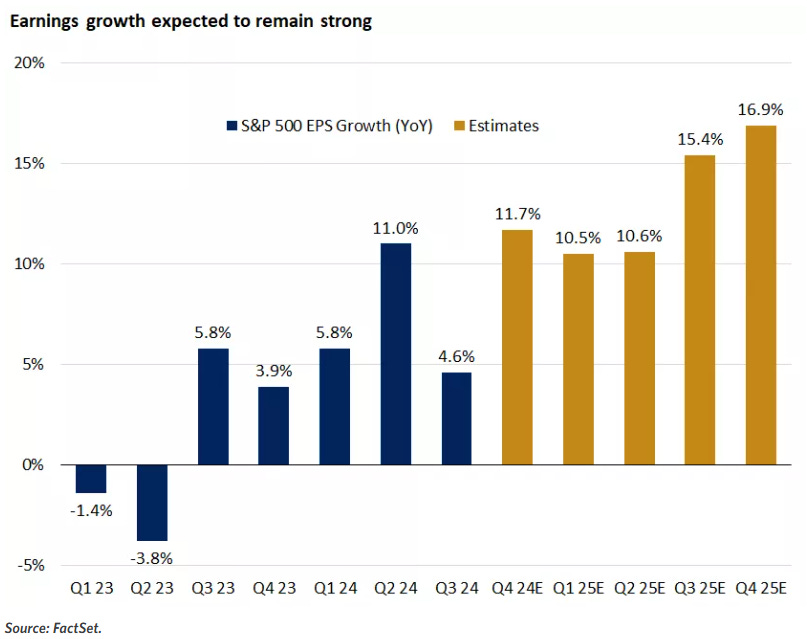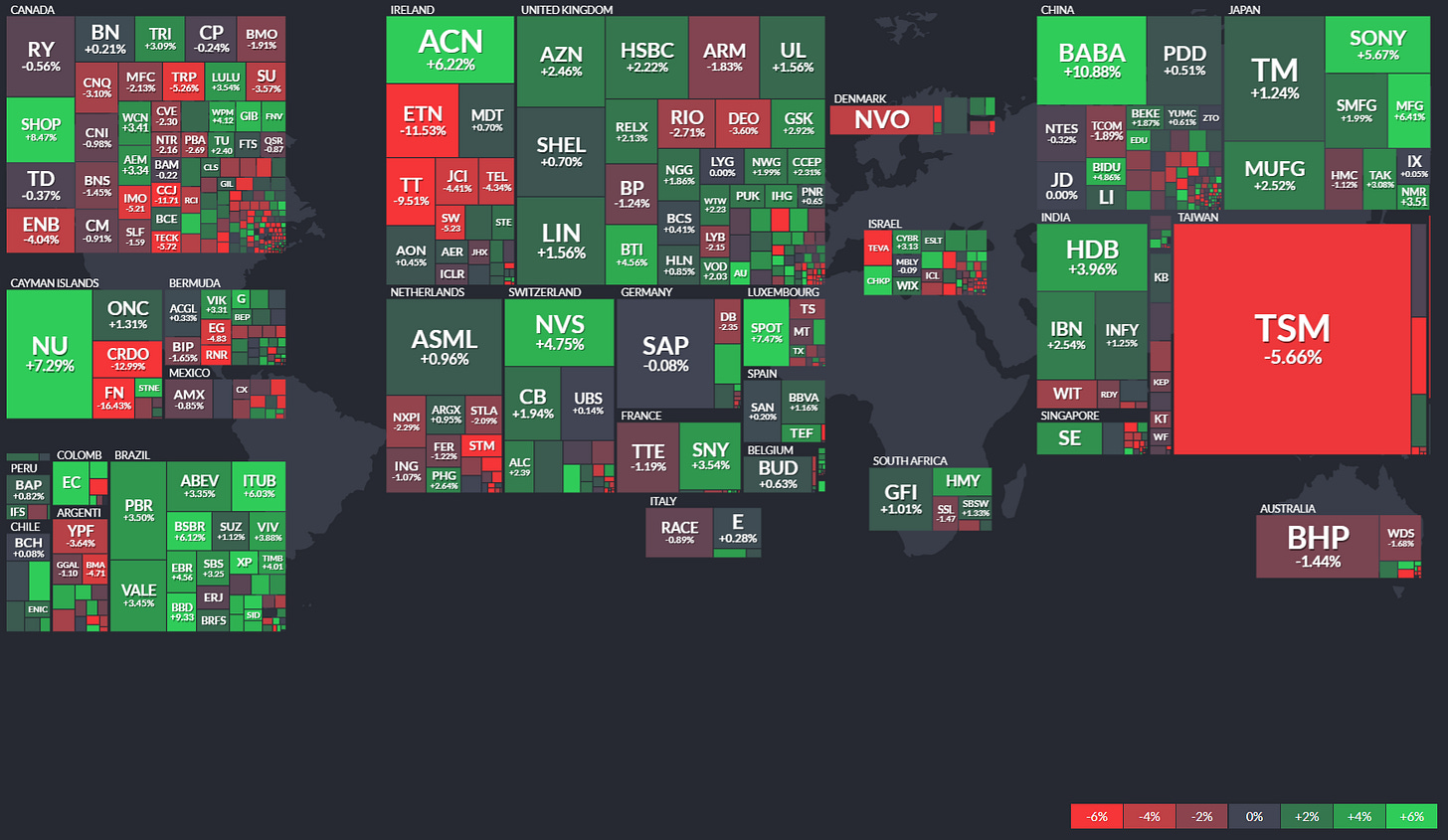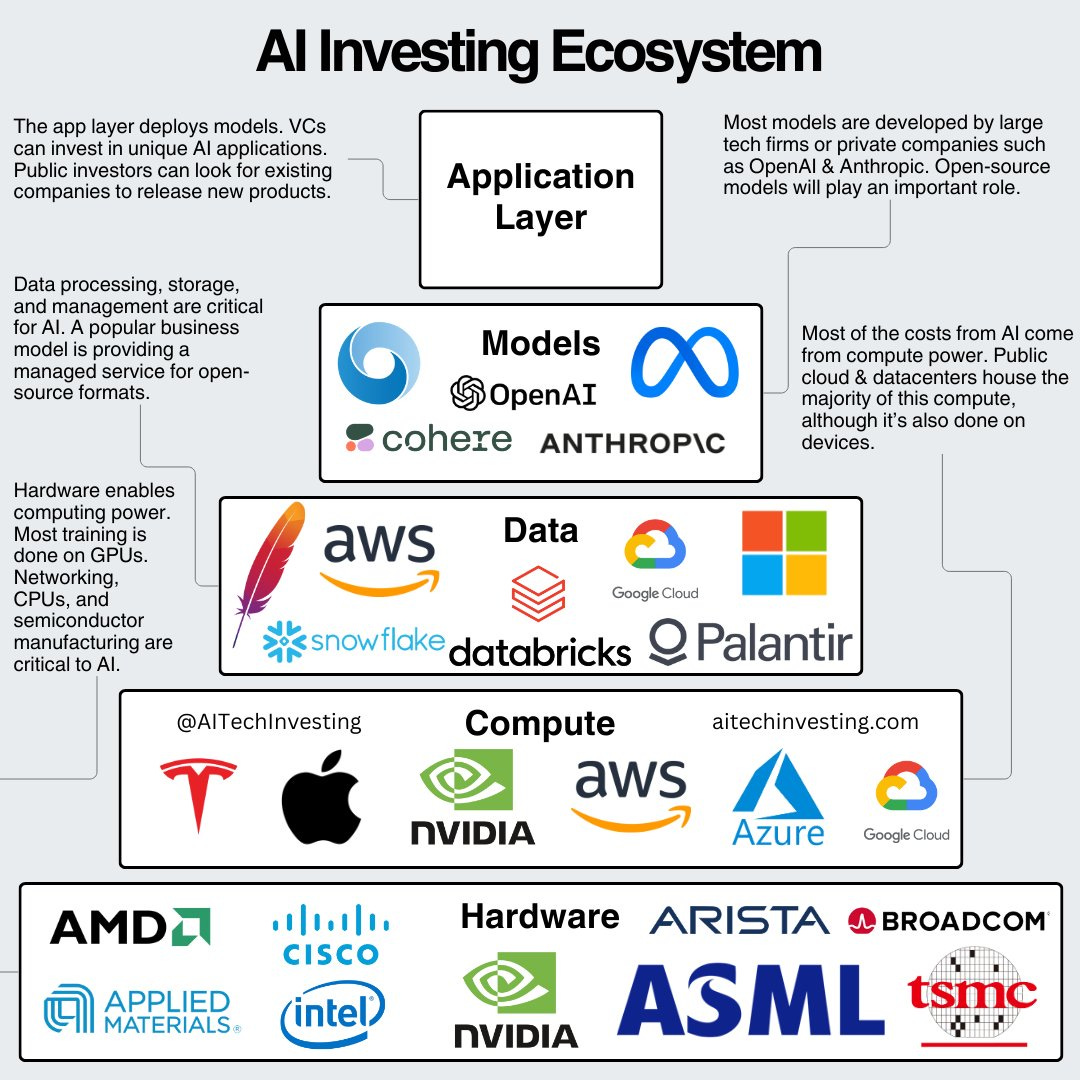Market Momentum: Your Weekly Financial Forecast & Market Prep
Issue 31 / What to expect Feb 03, 2025 thru Feb 07, 2025
In This Issue
Market-On-Close: All of last week’s market-moving news and macro context in under 5 minutes + futures-snapshots
Special Coverage: AI Investing & Lessons From The Recent Deepseek Controversy
The Latest Investor Sentiment Readings
Institutional Support & Resistance Levels For Major Indices: Exactly where to look for support and resistance this week in SPY, QQQ, IWM & DIA
Institutional Activity By Sector: Institutional order flow by sector including the top institutionally-backed names in those sectors. We break it all down and provide the key insights and take-aways you need to navigate institutional positioning this week.
Top Institutional Order Flow In Individual Names: All of the largest sweeps and blocks on lit exchanges and hidden dark pools
Investments In Focus: Bull vs Bear arguments for TDOC, TROW, INOD
Top Institutionally-Backed Gainers & Losers: An explosive watchlist for day traders seeking high-volatility
Normalized Performance By Thematics YTD (Sector, Industry, Factor, Energy, Metals, Currencies, and more): which corners of the markets are beating benchmarks, which ones are overlooked and which ones are over-crowded
Key Econ Events and Earnings On-Deck For This Week
Market-On-Close
A Week of Turbulence: Navigating the U.S. Financial Markets
The final week of January 2025 was marked by significant volatility in the U.S. financial markets, driven by a confluence of corporate earnings reports, geopolitical developments, and economic data releases. This period underscored the intricate interplay between policy decisions, market sentiment, and economic indicators.
Market Performance Overview
On Friday, January 31, the major U.S. stock indices closed lower, erasing earlier gains. The S&P 500 Index declined by 0.50%, the Dow Jones Industrial Average fell by 0.75%, and the Nasdaq Composite decreased by 0.14%. This downturn was primarily attributed to the White House's announcement that President Trump would proceed with imposing tariffs of 25% on imports from Mexico and Canada, and 10% on goods from China, effective February 1. The immediate implementation of these tariffs heightened concerns about potential economic disruptions and inflationary pressures.
Corporate Earnings and Sector Movements
The week was pivotal for corporate earnings, with several major companies reporting their fourth-quarter results. Apple Inc. reported earnings that slightly exceeded analysts' expectations, despite a miss in iPhone sales. The company's gross margin reached an all-time high, bolstered by growth in its services segment. However, the announcement of impending tariffs overshadowed these positive results, contributing to the broader market decline.
NVIDIA Corporation faced a significant setback, with its shares plummeting by 17% following the emergence of DeepSeek, a Chinese artificial intelligence startup. DeepSeek's new AI model, which reportedly operates with greater efficiency and lower costs, posed a competitive threat to U.S. tech companies, leading to a broad sell-off in the technology sector.
In contrast, IBM experienced a 13% surge in its stock price, driven by investor confidence in its AI strategy. The company's focus on integrating AI into its product offerings resonated with the market, highlighting the growing importance of artificial intelligence across industries.
Economic Indicators and Federal Reserve Actions
The U.S. economy demonstrated resilience, with fourth-quarter GDP growing at an annualized rate of 2.3%, slightly below the anticipated 2.4%. Consumer spending remained robust, increasing at a 4.2% annualized rate—the highest since the first quarter of 2023. However, declines in investment and exports moderated overall growth. For the entire year of 2024, the economy expanded by 2.8%, marginally below the 2.9% growth in 2023.
The Federal Reserve concluded its January meeting by maintaining the federal funds rate at 4.25% to 4.50%. The decision reflected a cautious approach amid solid economic growth and persistent inflationary pressures. The core Personal Consumption Expenditures (PCE) price index, the Fed's preferred inflation measure, rose by 2.8% year-over-year in December, remaining above the central bank's 2% target.
Geopolitical Developments and Market Sentiment
Geopolitical tensions influenced market dynamics, particularly with the announcement of new tariffs. The immediate implementation of tariffs on key trading partners raised concerns about supply chain disruptions and increased costs for consumers and businesses. These developments contributed to heightened market volatility, as investors grappled with the potential economic implications.
Conclusion
The week highlighted the sensitivity of financial markets to a complex array of factors, including corporate performance, economic data, and policy decisions. As the U.S. economy navigates these challenges, market participants remain vigilant, assessing the potential impacts on growth, inflation, and investment strategies. The interplay between technological advancements, geopolitical tensions, and economic indicators will continue to shape the financial landscape in the coming months.
5-Day Futures Performance Leaders
S&P 500 Sector Insights
ETF Insights
Global Overview
Special Coverage: AI Investing & Lessons From The Recent Deepseek Controversy
Artificial intelligence (AI) has become one of the most transformative and rapidly evolving sectors in modern technology. Its potential to revolutionize industries ranging from healthcare to finance and beyond has attracted immense investor interest, driving exponential growth in valuations and corporate investments. However, with these opportunities come significant risks and volatility, as evidenced by recent market reactions to developments like DeepSeek—a Chinese AI company that briefly sent shockwaves through the sector. For investors navigating this dynamic space, understanding the nuances of market sentiment, technological advancements, and geopolitical complexities is critical for capitalizing on AI’s long-term potential.
Here we examine key takeaways from recent developments in the AI landscape, the volatility inherent in the sector, and the prospects for continued growth following an already impressive run. By examining the lessons from events like the DeepSeek controversy and analyzing broader market trends, AI investors can continue balancing opportunity and risk.
The DeepSeek Episode: Lessons in Market Volatility
In late 2024, viral social media posts claimed that DeepSeek, a Chinese AI company, had replicated the capabilities of U.S.-based OpenAI at a fraction of the cost—just $6 million. The narrative quickly gained traction, erasing $1 trillion in market value from U.S. tech stocks and triggering a 17% drop in Nvidia’s stock price. This reaction underscores the hypersensitivity of the AI market to news and speculation.
The Reality Behind the Hype
Despite the initial panic, deeper analysis revealed that the $6 million figure cited by DeepSeek referred only to the final training run for its DeepSeek-V3 model, excluding significant research and development costs. Moreover, the model’s development relied heavily on U.S.-made GPUs, such as those from Nvidia. The misleading comparison between DeepSeek’s training costs and the broader investments made by U.S. companies highlighted the importance of contextualizing claims in the AI space.
Implications for Investors
The DeepSeek episode serves as a cautionary tale about the volatility of the AI sector and the need for a disciplined, long-term approach to investing. Rapid market reactions to unverified claims can create buying opportunities for investors who focus on fundamentals rather than hype.
The Early Stages of AI Adoption
Despite its transformative potential, AI remains in the early stages of adoption. Companies like Meta have announced plans to invest tens of billions of dollars annually in AI infrastructure, underscoring the sector’s long runway for growth. These investments aim to expand AI applications across industries, from automating routine tasks to enabling groundbreaking innovations.
Expanding Applications
AI’s versatility ensures its integration into a wide range of sectors. In healthcare, AI-powered diagnostics and personalized treatment plans are improving patient outcomes. In finance, AI algorithms optimize trading strategies and enhance fraud detection. Autonomous vehicles, powered by AI, promise to revolutionize transportation, while AI-driven tools in education and entertainment are enhancing user experiences.
Investment Implications
For investors, this broadening range of applications translates into multiple avenues for growth. Companies with strong positions in AI infrastructure, software, and niche applications are well-positioned to capitalize on this expanding market.
The Central Role of Hardware in AI’s Growth
AI’s rapid advancement relies heavily on high-performance hardware, particularly GPUs. Nvidia has emerged as a dominant player in this space, providing the computational power needed to train and deploy advanced AI models. The reliance of companies like DeepSeek on Nvidia’s hardware underscores its critical role in the AI ecosystem.
Sustained Demand for GPUs
As AI models become more sophisticated, their computational requirements increase. This trend ensures sustained demand for high-performance hardware, benefiting companies like Nvidia. Additionally, the development of AI-specific chips and architectures, such as Nvidia’s Tensor Cores, further solidifies its leadership position.
Opportunities for Investors
Investors should consider exposure to hardware providers as a foundational component of their AI portfolios. The growing computational demands of AI ensure a long-term growth trajectory for this segment of the market.
Innovation and Differentiation in the AI Space
The DeepSeek episode also highlights the importance of innovation and differentiation in the AI market. While cost-effective solutions like those pioneered by DeepSeek can gain attention, they often build on existing infrastructure and lack the foundational breakthroughs needed to disrupt established players.
Cost Optimization vs. Foundational Innovation
DeepSeek’s reliance on techniques like distillation—which optimizes smaller models using larger ones—illustrates the potential for cost-effective innovations. However, these approaches often depend on the foundational work of industry leaders, such as OpenAI and Google DeepMind. Companies with the resources to invest in foundational research and development maintain a significant competitive edge.
Strategic Focus for Investors
Investors should prioritize companies with a track record of innovation and significant R&D investments. These companies are better positioned to lead in an increasingly competitive landscape.
Global Competition and Regulatory Complexities
The AI sector operates within a complex geopolitical environment, with the U.S. and China vying for dominance. This competition introduces both opportunities and risks for investors.
Geopolitical Rivalry
Export restrictions on U.S. AI hardware, such as GPUs, highlight the growing tension between the U.S. and China. While these restrictions aim to limit China’s technological advancements, they also create challenges for U.S. companies seeking to access the Chinese market.
Regulatory Scrutiny
As AI becomes more pervasive, regulatory scrutiny is increasing. Issues such as data privacy, algorithmic transparency, and ethical considerations could impact how companies develop and deploy AI technologies. Investors should monitor regulatory developments closely, as they could influence the competitive landscape.
Balancing Growth and Valuations
AI’s rapid growth has led to impressive valuations for many companies in the space. While this reflects the sector’s potential, it also raises concerns about near-term upside and the sustainability of current valuations.
Lofty Valuations
The strong performance of AI companies, particularly in 2023 and 2024, has driven up valuations. While these reflect investor optimism, they may limit near-term upside as markets digest past gains.
Sustained Tailwinds
Despite high valuations, the fundamental drivers of AI growth remain intact. The increasing adoption of AI across industries, coupled with sustained investments from leading companies, ensures a robust growth trajectory over the long term.
Investment Strategies for AI Investors
To navigate the volatility and capitalize on the growth potential of the AI sector, investors should adopt a disciplined and diversified approach.
Diversify Across the Ecosystem
AI’s growth extends beyond hardware and software. Investors should consider exposure to cloud service providers, data analytics firms, and niche AI applications to capture the full spectrum of opportunities.
Focus on Quality
Companies with strong leadership, significant R&D investments, and competitive moats are better positioned to weather volatility and sustain long-term growth. Investors should prioritize quality over hype.
Prepare for Volatility
AI’s transformative potential attracts significant market attention, leading to sharp valuation swings. Investors should view market dips as opportunities to accumulate positions in high-quality names.
Monitor Emerging Players
Smaller firms like DeepSeek can drive innovation and disrupt traditional cost structures. While these companies may not threaten established players, they offer valuable insights into emerging trends and potential investment opportunities.
Conclusion: A Long-Term View on AI
The AI sector represents one of the most exciting and transformative investment opportunities of our time. While volatility is a given, the sustained investment from leading companies, the broadening range of AI applications, and the reliance on high-performance hardware ensure a solid growth trajectory for the long term. By focusing on fundamentals, diversifying across the ecosystem, and maintaining a long-term perspective, investors can navigate the challenges of this dynamic space and capitalize on its immense potential.
As the DeepSeek episode demonstrates, the AI market is highly sensitive to news and speculation. However, the underlying drivers of growth—innovation, infrastructure investment, and expanding applications—remain strong. For investors willing to embrace volatility and adopt a disciplined approach, the AI sector offers unparalleled opportunities for growth and transformation.























